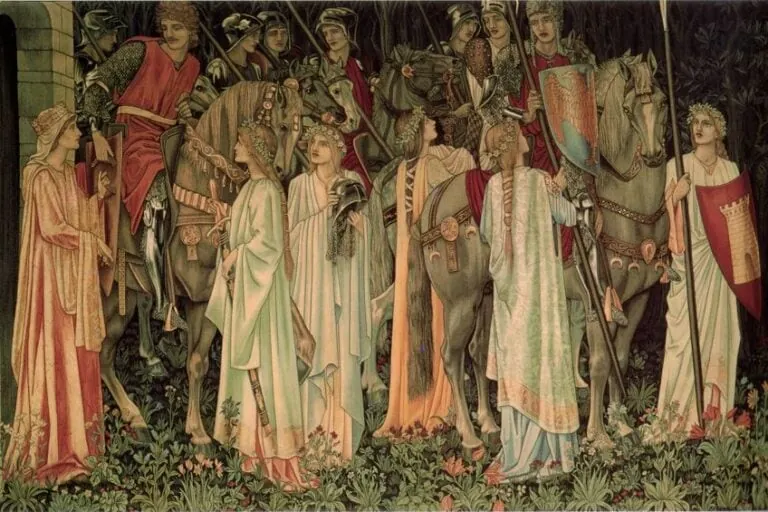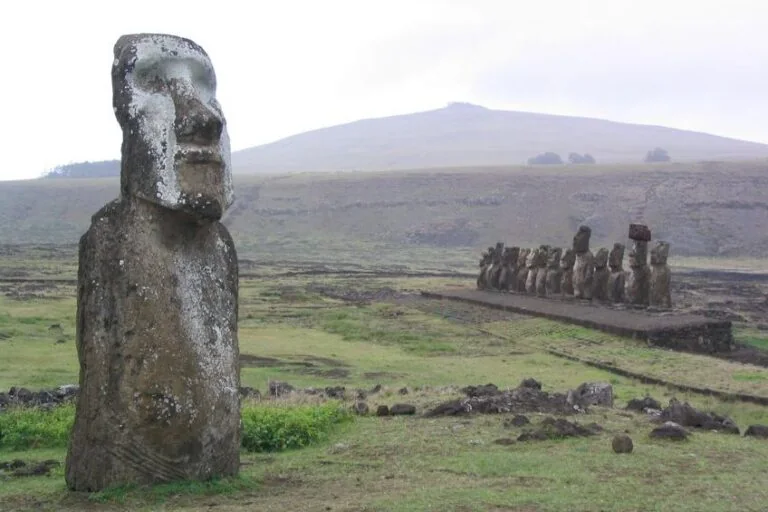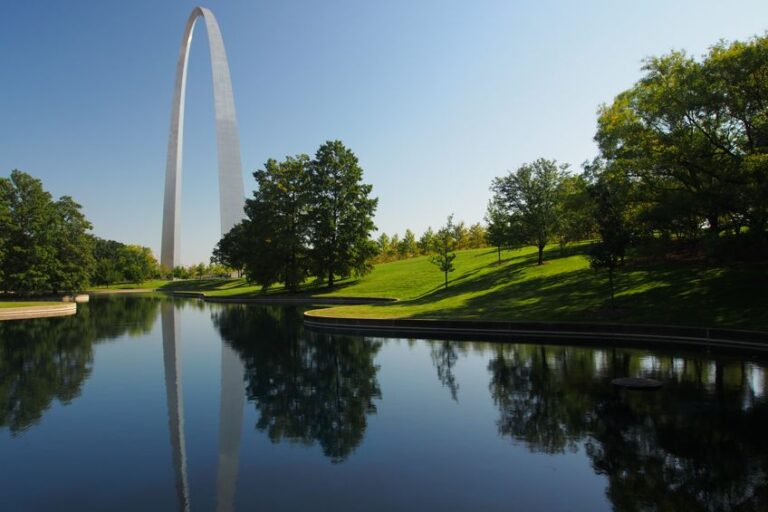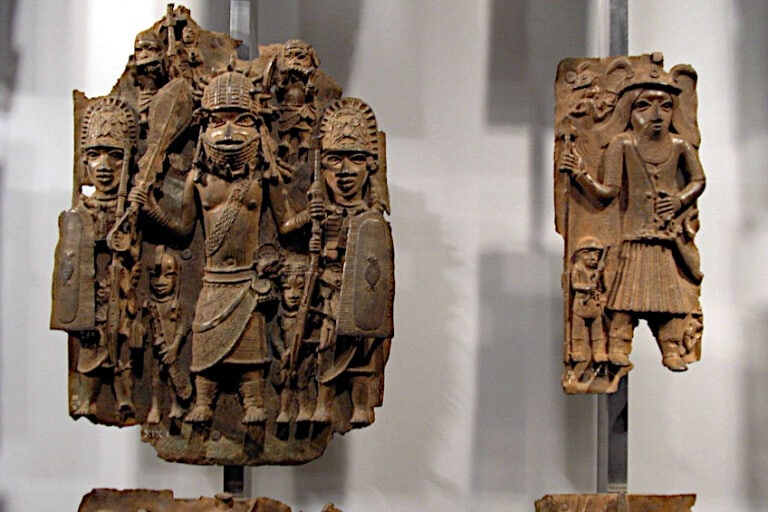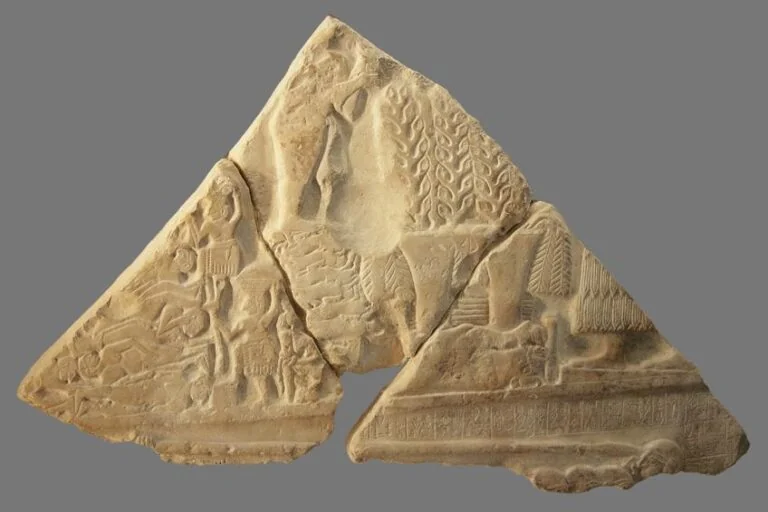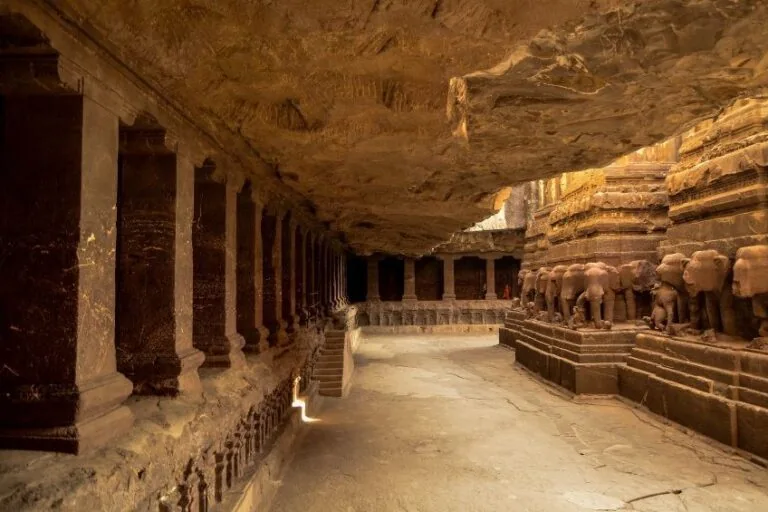“Doryphoros” Spear-Bearer – The Principles of Greek Sculpture
The spear-bearer Doryphoros is one of the most influential sculptures of the Greek antiquity period. The above life-sized statue of a muscular male figure has been admired as one of the best works of the famous bronze sculptor, Polykleitos, who operated during the 5th century BCE. This article will introduce you to the iconic spear-bearer Doryphoros of Polykleitos and why the sculpture is so significant in art history.
Polykleitos: A Sculptor of Classical Antiquity
| Artist Name | Polykleitos (Ancient Greek: Πολύκλειτος), or Polyclitus |
| Date of Birth | 480 BCE |
| Date of Death | 420 BCE |
| Place of Birth | Greece |
Polykleitos was known as one of the finest Greek sculptors in the history of Classical Greek antiquity. One cannot study sculpture without noting the artisanal talents of this 5th-century sculptor and his influence on the broader art form. Polykleitos’ contribution to classical society was marked by his text on the perfection of the male form through mathematical input and the expression of perfect body proportions. His text, known as the Canon of Polykleitos (c. 440 BCE), outlines his viewpoint on the perfect male physique and can also be seen in his sculpture Doryphoros.
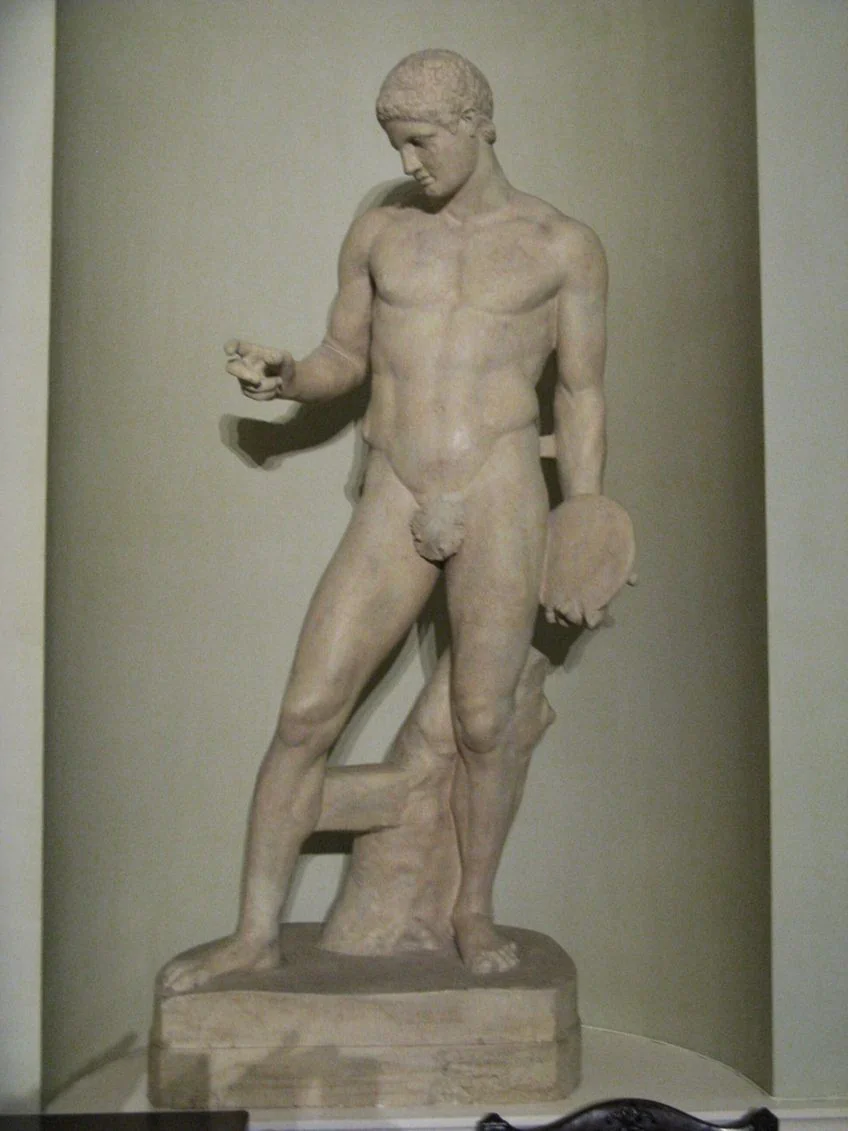 Discophorus (c. 5th Century BCE) by Polykleitos; Yair Haklai, CC BY-SA 3.0, via Wikimedia Commons
Discophorus (c. 5th Century BCE) by Polykleitos; Yair Haklai, CC BY-SA 3.0, via Wikimedia Commons
Polykleitos also goes by other names – according to Latin writers such as Pliny the Elder and other philosophers like Plato, he is best known as Sicyonius. It is believed that Polykleitos was from Argos, a city-state where it is also presumed that he received his early education. Other notable works by Polykleitos include a sculpture of an Amazon and a statue of Hera, which was placed at the Heraion of Argos (Hera’s temple).
Other popular sculptures that are considered works by Polykleitos include Discophorus (c. 5th century BCE) and Astragalizontes (c. 5th century BCE).
The Doryphoros of Polykleitos
| Date | c. 450 – 440 BCE (original); 120 – 50 BCE (marble copy) |
| Medium | Bronze (original); marble (copy) |
| Dimensions (cm) | 212 (h) |
| Where It Is Housed | Naples National Archaeological Museum, Naples, Italy |
| Movement/Style | Classical Realism |
In sculpture, the pursuit of the perfect human form was a reflection of beauty and the ultimate representation of man and harmony. Art provided the outlet through which many could explore the ideals of beauty and strive toward the creation of an ideal human form. Polykleitos was one such artist who was dedicated to the establishment of a perfect human form and solidified his pursuit in the form of a nude male sculpture known as the spear-bearer, Doryphoros.
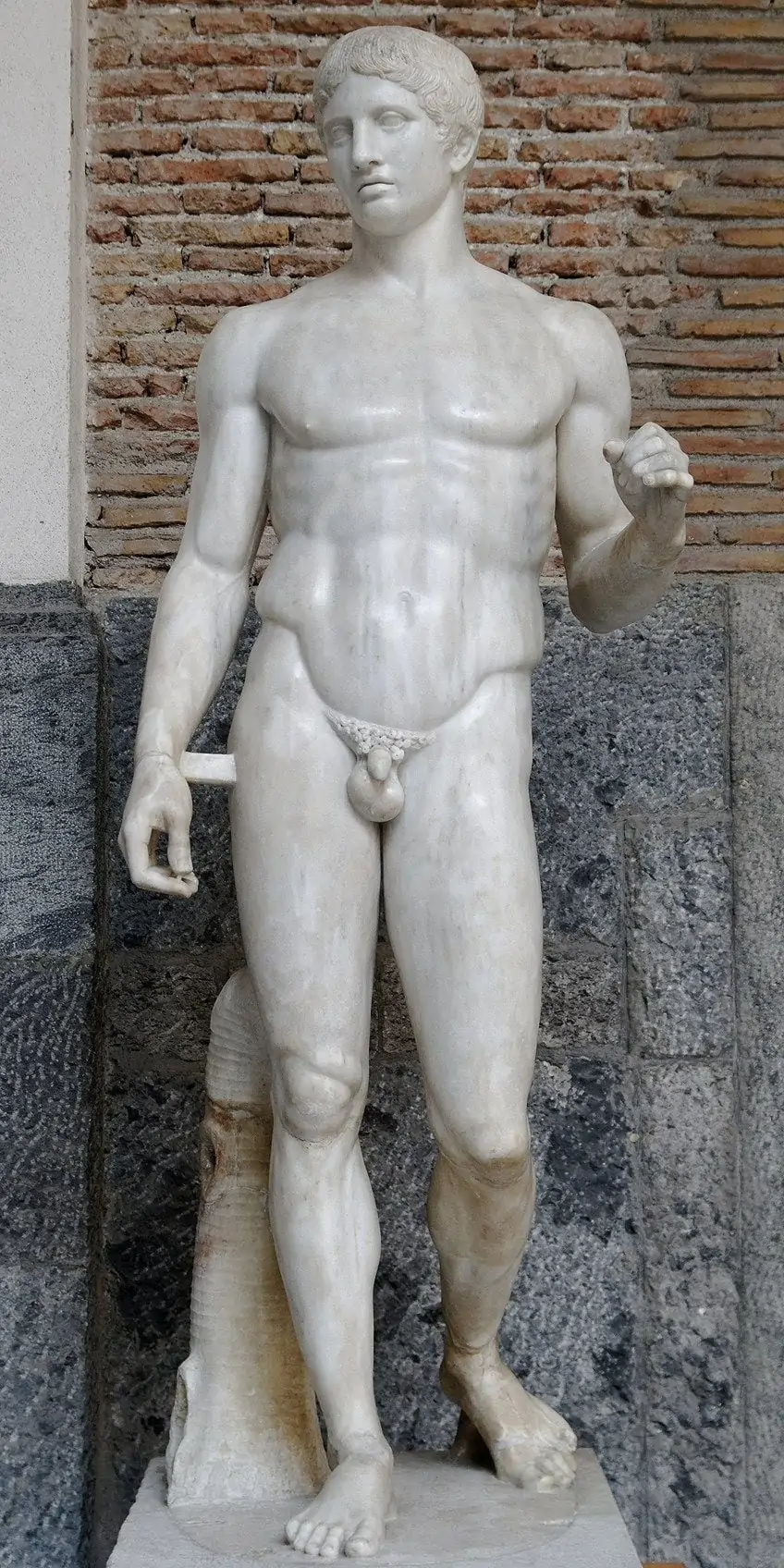 Doryphoros from Pompeii (1st century BC) after Polykleitos; After Polykleitos, CC BY 2.5, via Wikimedia Commons
Doryphoros from Pompeii (1st century BC) after Polykleitos; After Polykleitos, CC BY 2.5, via Wikimedia Commons
When was the spear-bearer created? The spear-bearer Doryphoros was created sometime around 440 BCE and was originally a bronze sculpture. The only surviving references to the original work are the many copies replicated by the Romans from the original sculpture. A marble copy exists in the Naples National Archaeological Museum and is considered the best copy of Doryphoros. Around the 2nd century, a medical writer called Galen once remarked on the essence of Doryphoros as a “perfect visual expression” of the Greek aspiration for harmony and beauty, essentially a representation of vanity and ideals.
Polykleitos was so obsessed with the idea of defining and discovering the perfect male proportions that his main subject matter in sculpture was athletes. His interest was further cemented in his essay on the symmetry of the human body and his canon became known as the primary inspiration for the spear-bearer. The ratio that Polykleitos used to create the marble copy was one to seven for the head-to-body ratio.
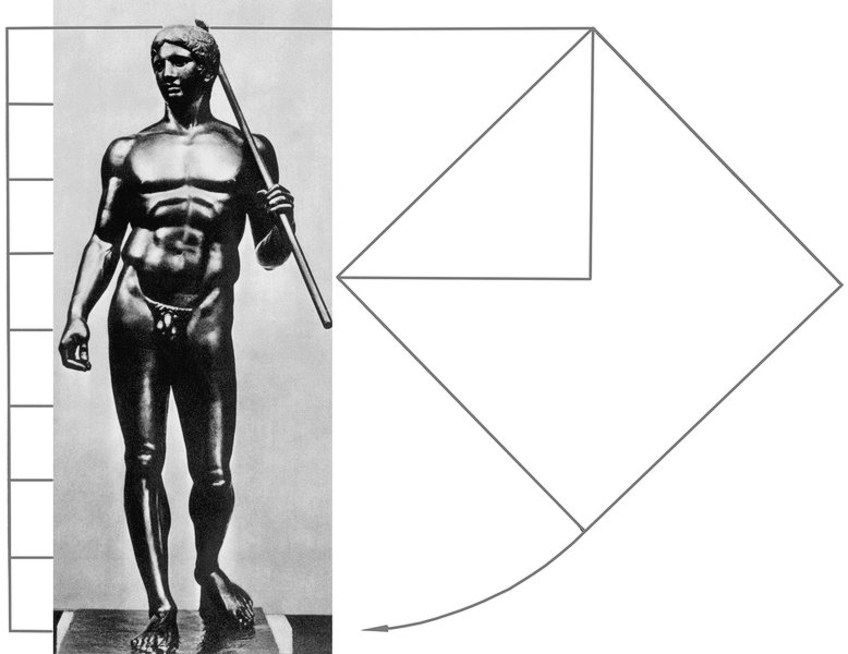 A proportional diagram showing the “square figure” of Doryphoros, reconstruction by V.G. Vlasov, 1989; Polykleitos, Public domain, via Wikimedia Commons
A proportional diagram showing the “square figure” of Doryphoros, reconstruction by V.G. Vlasov, 1989; Polykleitos, Public domain, via Wikimedia Commons
The figure itself depicts a nude athletic figure with his head angled to the right and positioned in a moment as though he is stepping into action. His left hand is said to have originally held a spear and the sculpture’s stance is a perfect example of the Classical contrapposto pose as defined by the angled hips. The spear-bearer’s right leg is straightened as a support for his body. His right arm appears to fall to his side with no weight and is known to be one of the first examples of a free-hanging arm in sculpture.
The Spear-Bearer in the Ancient World
So, why was Doryphoros, or Spear-Bearer, famous throughout the ancient world? It is important to remember that the art of the Greeks was extremely appealing to their counterparts, the Romans, who even went to the extent of reproducing many of the famous Greek sculptures we know today. Around 211 BCE, when the Romans began conquering the Greeks, many generals returned to Rome with not only precious loot but artworks as well. The elite members of society were so impressed that they even established new studios dedicated to the reproduction of Greek sculptures that would soon occupy the homes of many wealthy individuals. Polykleitos’ Doryphoros was one such sculpture that was in demand and is known to be one of the most reproduced sculptures in ancient history.
The reproduction of artwork was predominantly executed using marble since many Greek bronze artworks that were looted were eventually melted down and turned into weapons. Marble was the preferred medium for the Romans as seen in the Roman copy of Doryphoros in the Naples National Archaeological Museum.
Before the reproduction of Doryphoros, the standards of beauty were of high priority to the ancient Greek world and its manifestation had been realized by Polykleitos. As you can imagine, the Romans must have found the sculpture to be incredibly valuable and thus all members of elite society would have demanded a copy. When imagining divine proportions or standards of human beauty, one often draws comparisons to Leonardo da Vinci’s work on the Vitruvian Man. The earliest examples of beauty standards in the ancient world fall with the Egyptians whose ideals predate that of Polykleitos, classical antiquity, and the Renaissance. The allure of a mathematical relationship to beauty and the potential establishment of such a standard was heightened with Doryphoros.
You might also find it interesting to know that the nudity of classical Greek sculpture was also a marker to distinguish the “sophisticated Greeks” from the Romans and thus male nudity became a symbol of civilization, progression, beauty, and the new standard. If one observes the statue closely, one would notice that the face of the spear-bearer lacks any clarity in identification or defined features and appears to be a generic representation of the idealized Greek citizen. This brings us to the idea of perfection, which many acknowledged as unattainable yet still a standard in the ideal world of the Greeks.
The Contrapposto Pose and Symmetria
The contrapposto pose is defined as one of the elements of Polykleitos’ Canon on bodily symmetry. The pose is characterized by one part of the male figure turned in opposition to the other half with the weight of the body placed on one foot to provide a counterbalance for the body’s central axis. Polykleitos was a key figure in perfecting the depiction of this pose in sculpture and in Doryphoros, he demonstrated the contrapposto through the spear-bearer’s shoulders and hips. The positioning of the statue’s legs also portrays the figure as being caught mid-stride and causes the left hip to angle downward. Polykleitos counterbalances the hip with the left shoulder facing upward, which creates symmetry as defined in Polykleitos’ beauty canon.
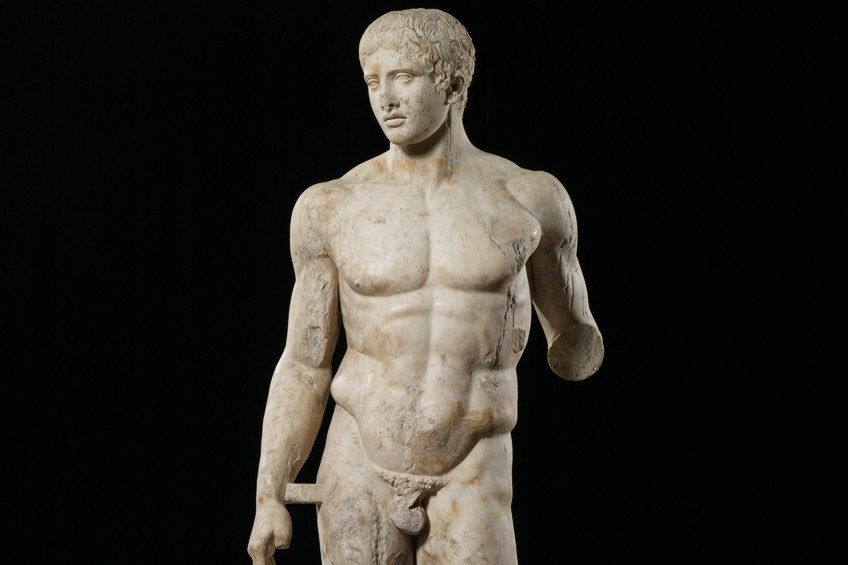 Doryphoros, 120–50 BCE, Minneapolis Institute of Art, after Polykleitos; Minneapolis Institute of Art, Public domain, via Wikimedia Commons
Doryphoros, 120–50 BCE, Minneapolis Institute of Art, after Polykleitos; Minneapolis Institute of Art, Public domain, via Wikimedia Commons
It is also important to understand that the world of the Ancient Greek civilization was very much interconnected in terms of a multidisciplinary approach to culture and education. The majority of artists were aware of mathematical concepts and often incorporated such ideas into their art while many mathematicians were equally aware of artistic theories and concepts. Sculpture and symmetry in Ancient Greek art are therefore a reflection of the mingling of art, mathematics, and science that drove the aesthetic and beauty canon of the time.
The 5th century was also the height of the Greek High Classical style, which was the most mature style and a famous era of reproduced artworks. The High Classical period has since been termed the “Golden Age” of Greek art and was characterized by the increase in innovative ideas for many Greek artists. Polykleitos’ canon was thus regarded as somewhat of a beauty law for sculptors to follow centuries after his death.
The 5th century was also a period of emphasis on Realism in art and hence the importance of perfection in sculpture and beauty.
Polykleitos’ canon was more of a system aimed at providing a mathematical framework for future representations of nature (in its ideal form). In short, Polykleitos’ canon revolves around the idea of symmetria, which stipulated that all parts of the body needed to be equal with the measurements acting in unity and thus, harmony was born. The canon of symmetry and proportion was an innovation toward what was considered mathematically perfect and can be viewed as an achievement of creation, equal to that of the divine.
The Influence of Doryphoros
Polykleitos’ Doryphoros sculpture is one of the most famous sculptures of the 5th century and is also an early example of the ideal figure of masculinity. The Doryphoros sculpture is also one of the first artworks to introduce the contrapposto pose to sculpture. The contrapposto pose – or counter pose – has been imitated by numerous artists who followed in Polykleitos’ footsteps, including artists such as Michelangelo Buonarotti and many other masters of the Renaissance. The Doryphoros was a classical reference for many Renaissance artworks and its representation of the ideal male body was celebrated.
Another unknown artist also produced a copy of Doryphoros, which can be viewed at the Minneapolis Institute of Art. This copy dates to between 27 and 68 CE and was crafted out of Pentelic marble. Although most Roman sculptures were copies of famous Greek sculptures, they were not as accurate as the original bronze artworks and many surviving marble sculptures are often found damaged or missing limbs. Perhaps also inspired by Doryphoros is another bronze sculpture called the Antikythera Youth housed at the National Archaeological Museum in Athens.
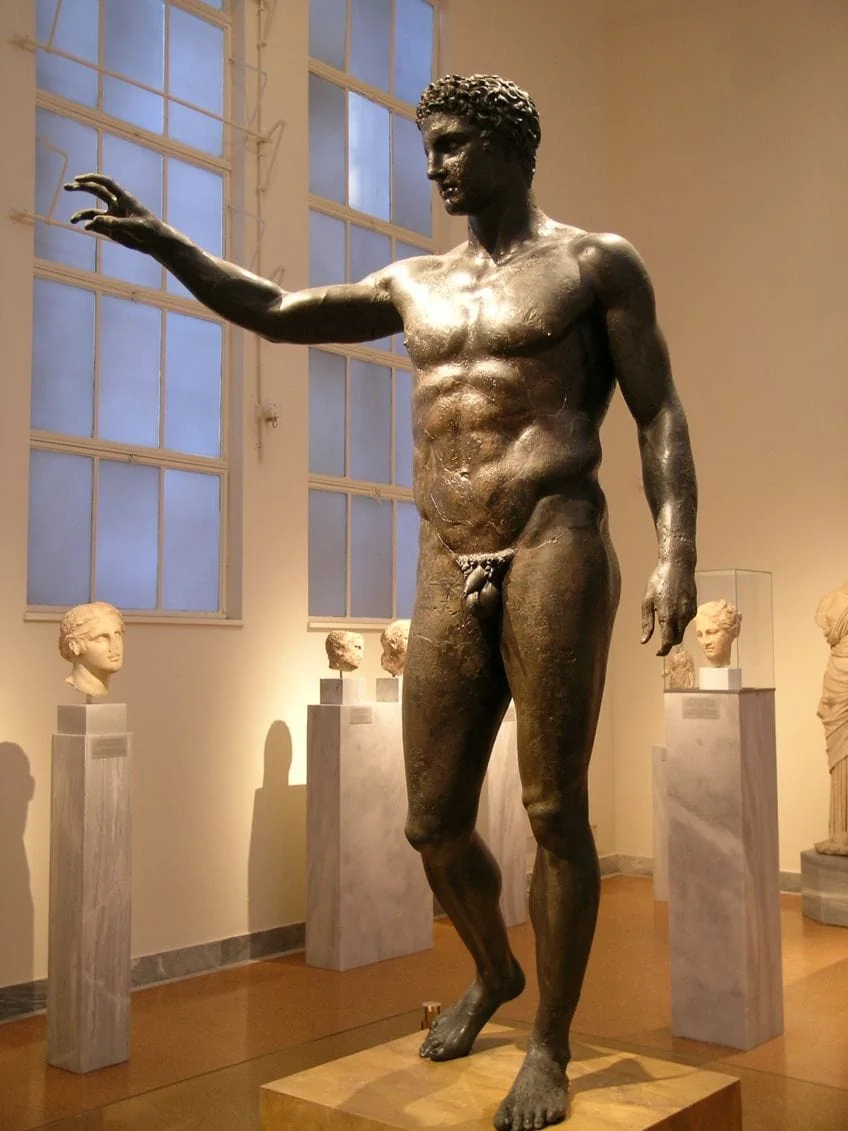 Antikythera statue (340-330 BCE); Ishkabibble at the English Wikipedia, CC BY-SA 3.0, via Wikimedia Commons
Antikythera statue (340-330 BCE); Ishkabibble at the English Wikipedia, CC BY-SA 3.0, via Wikimedia Commons
The influence that the canon of ideal masculine beauty had on the ages to follow was immense. Despite the art of classical antiquity being hidden away throughout the Middle Ages, its rediscovery during the Renaissance-inspired many authors, poets, painters, and sculptors to re-invent the male nude. The male nude in ancient Greece was also associated with social practices such as gymnasiums and the display of the male nude was seen as a display of the elite.
The nude as depicted in Doryphoros is one of three important representations of masculinity in Classical antiquity. The male nude was celebrated in three forms; the young male nude (boyish nude), athletic figures such as Doryphoros, and lastly the muscular masculine nude as seen in popular depictions of the Greek God Hercules. Athletic nudes such as Doryphoros also served as a form of comfort for society since it was contrasted by the many conflicts and tribulations of 5th-century Greece.
Doryphoros is a complex sculpture embedded with traditions and idealistic world views of beauty as prioritized in the past. Polykleitos and the manifestation of his ideal canon of beauty can be considered the height of the fragile state of a bygone Classical era that worshiped the male nude as a form of escapism while highlighting the unattainable nature of ultimate divine perfection when it comes to beauty.
Frequently Asked Questions
What Does the Doryphoros of Polykleitos Represent?
The Doryphoros sculpture, also known as the spear-bearer sculpture, represents the ideal male body seen as athletic and muscular. The ideal male body was part of Polykleitos’ canon of beauty that was defined by mathematically-fueled proportions for the perfect human form.
Why Was Doryphoros, or Spear-Bearer, Famous Throughout the Ancient World?
Doryphoros, or Spear-Bearer, was famous throughout the ancient world and particularly in Greek sculpture since it is one of the first sculptures to introduce the contrapposto pose in a statue and was one of the most famous sculptures from Classical antiquity due to its affiliation with Polykleitos’ canon of ideal beauty, the perfectionism of the human form, and divine masculinity via mathematically accurate proportion. Doryphoros was seen as a symbol of the elite and was sought after by many wealthy Roman members of society.
When Was the Spear-Bearer Created?
The Spear-Bearer sculpture was created between 450 and 440 BCE by Polykleitos and was originally a bronze sculpture. The surviving copies of the Spear-Bearer sculpture were produced in marble by the Romans.

I am deeply passionate about history and am constantly fascinated by the rich and complex stories of the past. As the editor-in-chief of learning-history.com, I have the opportunity to share this passion with a wide audience through the creation and distribution of engaging and informative content about historical events, persons, and cultures. Whether it’s through writing articles and blog posts or creating videos or podcasts, I strive to bring the past to life in a way that is both accurate and enjoyable. My expertise in history, combined with my strong writing and communication skills, allows me to effectively communicate complex historical concepts and make them accessible and interesting to a wide range of readers. I am truly grateful for the opportunity to share my love of history with others through my work on learning-history.com.

